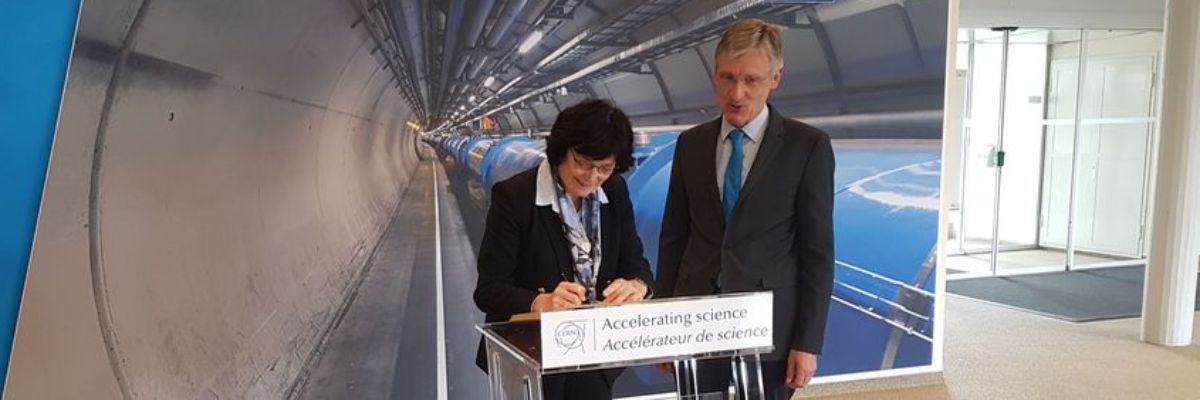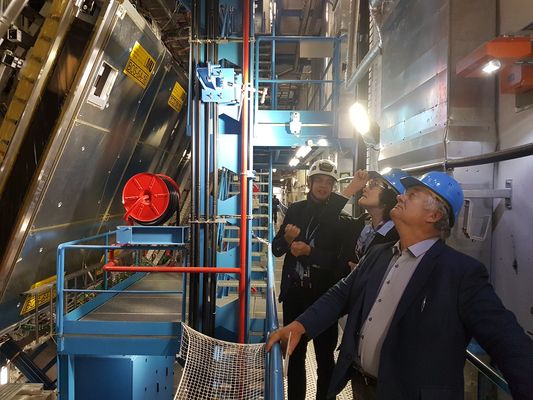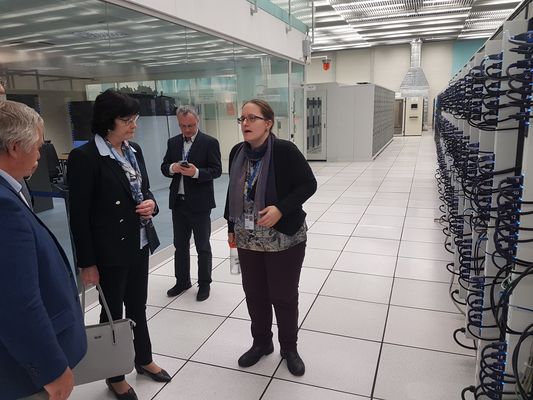
The leadership of the Czech Academy of Sciences visited CERN
03. 06. 2019
On Wednesday, May 29, the President of the Czech Academy of Sciences Eva Zažímalová visited one of the most significant scientific institutions in the world – CERN (European Organization for Nuclear Research) in Switzerland. The Czech expedition, attended also by the CAS Vice President Zdeněk Havlas and the CAS Academy Council Chair Antonín Fejfar, was guided by the CAS Vice President Jan Řídký, who had worked at CERN for three years.
“The meeting had several dimensions: we spoke with the CERN leadership and its users, we visited the top laboratories. We gained some insight into the directions in which the centre should evolve in the future. And on top of this, we discussed further possibilities of Czech cooperation, which is already quite extensive,” explains physicist Antonín Fejfar.
“Professor Zažímalová was interested by the presentation of detectors of the Medipix series, which are useful in detection of ionising radiation and visualisation of samples, for example in biology. The visit also included the President’s discussion with a large group of Czech scientists, technicians and students who work at CERN,” says one of the CAS Vice Presidents Jan Řídký, who had researched nuclear physics also in an international research centre, namely the Joint Institute for Nuclear Research in Dubno, Russia.

The CAS President Eva Zažímalová and the CAS Vice President Zdeněk Havlas in an underground tunnel of CERN
“I was impressed especially by the atmosphere of international friendship and diligence, and of course by the detector which has been used to physically locate Higgs bosons,” adds the CAS Vice President Zdeněk Havlas, praising also CERN’s distribution of funding. “Big money is invested in CERN, and I was pleasantly surprised how dutifully they watch the boundary between doing actual science and wasting the funds. This big money really ends in the underground facilities where research is done,” says Havlas.
Czech steel and detectors in ATLAS
The leadership of the Czech Academy of Sciences was mesmerised especially by the tour of the world’s largest particle accelerator called LHC (Large Hadron Collider). The LHC is placed in a deep underground corridor that forms an almost 30-kilometre-long tunnel between the Jura Mountains and Lake Geneva.
“We got to see its internal workings under the ground because currently the accelerator is inactive for two years due to maintenance and upgrades, so there was no radiation hazard,” says Fejfar. The highlight of the tour was the ATLAS detector whose tasks include searching for particles which might comprise dark matter. The detector consists of 8 giant magnets (of 25 metres each) and thousands of tons of detectors and electronics. “ATLAS is one of the key experiments at the LHC accelerator,” emphasises Jan Řídký.

The leadership of the CAS agrees that the Czech participation is clearly visible at CERN
“Currently, it is possible to visit also some parts of ATLAS that are normally hidden. To give you an idea of its size, it contains more steel than the entire Eiffel Tower. And a large part of the construction was delivered from the Czech Republic,” explains Fejfar. The Institute of Physics of the CAS, in close cooperation with the Crytur company from the Czech town of Turnov, also participated in the development and installation of the scintillation detectors. Czech Republic takes part not only in deliveries of materials and development of the detectors but oversees the test phase, as well. “Our Institute of Physics runs the testing, plus we participate in processing of data streams from CERN. The CERN results are virtually a flood of data,” elaborates Fejfar. “The Czech participation is really visible here,” says Havlas with contentment.
Cooperation with ELI Beamlines
The delegation from the Czech Academy of Sciences was received at CERN by the Director for Research and Computing Eckhard Elsen. Another important meeting was the one with the Head of Technology Department José M. Jiménez. “With him and his people we also discussed our ELI Beamlines laser centre in Dolní Břežany and mutual exchange of experience, including other ways of accelerating the particles. This was the only part of our tight schedule where we exceeded the time limit, but it was well worth it,” says Fejfar. The CAS Vice President Zdeněk Havlas adds that they also spoke at CERN about possible cooperation in the medicinal area.
CERN has big plans for the future: they consider increasing the current LHC accelerator’s luminosity tenfold by 2035, but they also have other projects such as the CLIC (Compact Linear Collider) or the FCC (Future Circular Collider), whose diameter is supposed to be the staggering 100 kilometres. According to studies, its energy could reach 100TeV, i.e. an order of magnitude more than the current accelerator.
The opening photo shows the CAS President Eva Zažímalová at CERN, Switzerland
Original Czech text prepared by: Alice Horáčková, Department of Media Communication of the Head Office of the CAS
Photo: Jan Řídký, Head Office of the CAS
Read also
- A trapped state: The pandemic impact on public attitudes, trust, and behavior
- Aerial archaeology: Tracing the footsteps of our ancestors from the sky
- Archaeologists uncover ancient finds along Prague Ring Road
- Our microbiome largely depends on what we eat, says microbiologist Michal Kraus
- The ABCs of writing: Why did its invention mark a turning point for humankind?
- We learn, remember, forget… What can memory actually do? And can we outsmart it?
- New Center for Electron Microscopy in Brno opens its doors to global science
- The hidden lives of waste: What can we learn from waste workers and pickers?
- A unique lab is hidden right beneath Prague’s Vítkov Hill
- Renewables are a strategic investment in European security, scientists say
The Czech Academy of Sciences (the CAS)
The mission of the CAS
The primary mission of the CAS is to conduct research in a broad spectrum of natural, technical and social sciences as well as humanities. This research aims to advance progress of scientific knowledge at the international level, considering, however, the specific needs of the Czech society and the national culture.
President of the CAS
Prof. Eva Zažímalová has started her second term of office in May 2021. She is a respected scientist, and a Professor of Plant Anatomy and Physiology.
She is also a part of GCSA of the EU.